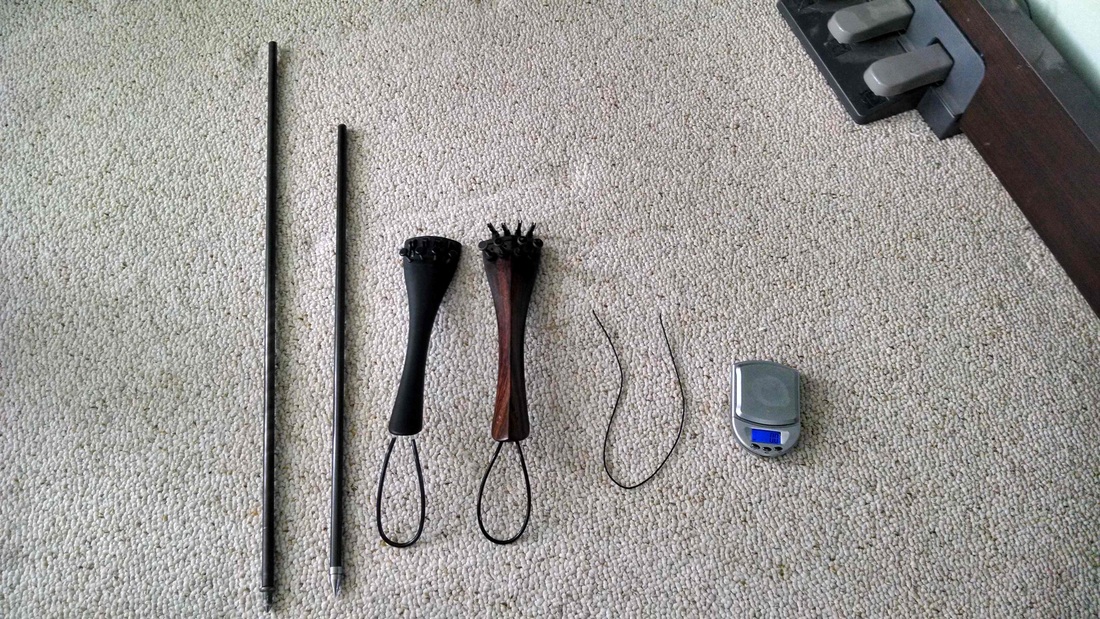I put my cello on a diet, and it lost about 158.3 grams. (I say about because I forgot to weigh the kevlar tailcord before I put it on, so I'm using half of the nylon one, which seems about right.) For reference, that's about as much as a normal-sized container of Chobani Greek Yogurt,
It all started about a year ago when I changed my tailpiece (the thing at the bottom of the cello to which the strings attach) from a very pretty wooden one (called the stock tailpiece from here on) to a boring black "composite" (plastic) one made by Wittner because it was supposed to improve the sound. Supposedly the composite material can conduct sound better, but mostly it's lighter (81.7g vs 149g), which means there's less mass hanging off the strings absorbing sound. Whatever the reason, it did make an incredible difference in the sound, to the point that my downstairs neighbor asked if I got a new cello. I was thrilled, because it sounded great and was pretty cheap. (~$40)
Then a month or two ago I swapped my endpin (the thing that comes out of the bottom and touches the floor) from the stock 24" x 10mm 154g hollow steel to a 20" x 10mm 67g New Harmony carbon fiber pin. The New Harmony has two advantages over the steel. First, it's needle sharp, which means it will stick into the stage floor and won't slip out from under you while you're playing, and second it's less than half the weight of my old one. (Again, less mass absorbing sound.) My old pin had to be removed by a luthier, and I had forgotten to bring the new one when I dropped my cello off. When I picked it up the next day (I had some other work done) I swapped the end pin out and played it. Everyone in the room noticed a difference. The luthier's words were 'It's really ringing now.' My wife's were 'I didn't expect to be able to tell the difference, but I can'. I was thrilled, because it sounded great, and it was pretty cheap. (~$75)
Finally this morning I made the last change, which was to take the tailpiece off and replace the stock nylon tailcord (the black loop that attaches to the cello) with a kevlar Bois d'Harmonie tailcord. I had read a lot of mixed reviews online about doing this. Some people loved it. Some people hated it. According to the internet, it would make my cello sound better, make it sound worse, make it louder, make it out of tune, make wolf tones worse, make wolf tones better, make it sound harsh, thin, fuller or more resonant. What I concluded from reading all the conflicting opinions was that it sounded like it would amp up your cello's natural sound. If you had a thin sounding instrument, it would make it thinner to the point of sounding harsh and tinny. If you had a boomy cello, it would push it over the edge and make it blatty and muddy. But if you had an instrument somewhere in the middle, it would make it give it a boost and make it better. The kevlar tailcord was only $10, so I decided to take the gamble and it a try.
This change isn't so much about weight as it is about flexibility. The kevlar string is a little bit lighter (roughly by half, mostly due to the brass nuts that are on the end of the nylon cord) but more than anything it's dramatically more flexible, which is supposed to allow your tailpiece to resonate more freely and (ideally) generate more sound. I'm fairly handy, and the cord came with decent instructions, so I took my cello apart and did it myself. It wasn't hard, but it was a little unnerving. My tailpiece is 1mm off from where it was with the nylon cord, so I'm pretty happy with the job.
But before I did this, I made recordings of my cello with different combinations of tailpieces and endpins so I could have something to somewhat objectively compare in the end. My cello is a 1998 Wyss Montagnana copy from Switzerland. I'd call it a high end student instrument. I tried to play as loudly as I could each time, and I tried to do the same thing each time - open string double stops, a C major scale, followed by a C major chord. First I'm posting comparisons of just that final chord. Then I'll post the full recordings for the super curious. I'd recommend you use decent headphones, because the differences are subtle through laptop speakers. In real-life they're not so subtle. Ignore the intonation issues. I took the strings off 3 times in about an hour, what do you expect?
My first impression when I started playing on the kevlar tailcord was that I could suddenly turn my cello up to 11. I know where it used to top out, and now it can take a little more. It's easier to play and more responsive, with a more open high register and a punchier low. It did make the sound a bit harsher, but I'm not sure if it's because I messed with the strings or because of the kevlar cord. It sounds like my strings haven't broken in yet, which tends to happen if you loosen them all the way for a while. I'll update this after I've had some time to play on it and see what it does. But in the meantime, I definitely think it was worth it.

 RSS Feed
RSS Feed